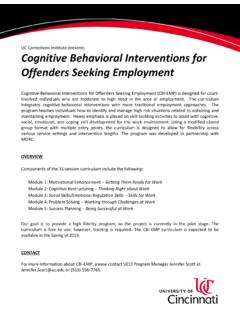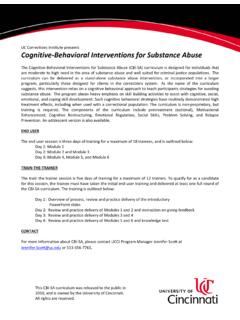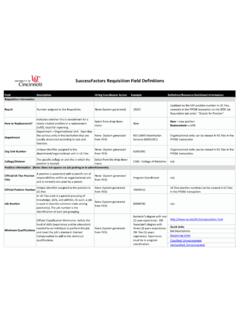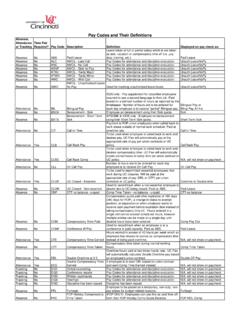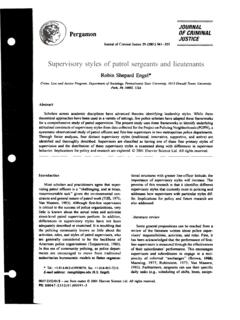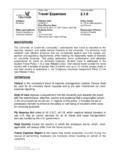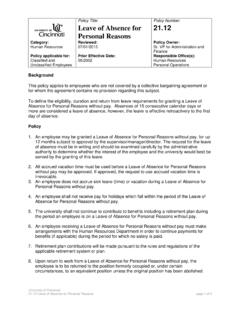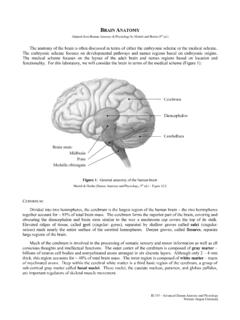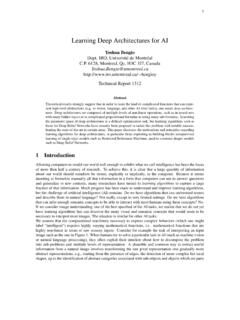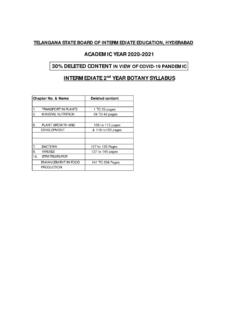Transcription of THE NERVOUS SYSTEM - University of Cincinnati
1 THE NERVOUS SYSTEM . COMPILED BY HOWIE BAUM. THE NERVOUS SYSTEM . The NERVOUS SYSTEM is the most complex body SYSTEM !! Constantly alive with electricity, the NERVOUS SYSTEM is the body's prime communication and coordination network. It is so vast and complex that, an estimate is that all the individual nerves from one body, joined end to end, could reach around the world two and a half times. The Brain and Spinal Cord are the Central NERVOUS SYSTEM . Nerves and sensory Organs Make Up the Peripheral NERVOUS SYSTEM . Together, the central NERVOUS SYSTEM (CNS) and the peripheral NERVOUS systems (PNS). transmit and process sensory information and coordinate bodily functions. The brain and spinal cord (the CNS) function as the control center. They receive data and feedback from the sensory organs and from nerves throughout the body, process the information, and send commands back out.
2 Nerve pathways of the PNS carry the incoming and outgoing signals. The Spinal Cord Transmits Signals to and from the Brain and Commands Reflexes The spinal cord is an elongated cylinder of neuron cell bodies, bundles of axons and other cells, protected by connective tissue and bone. It connects to the brain at the medulla oblongata and runs down the vertebral column, the hollow tunnel enclosed within the vertebrae of the spine. The spinal cord is part of the central NERVOUS SYSTEM and serves as a kind of superhighway. sensory information and motor commands travel up and down, heading to and from the brain. These signals speed in and out of the spinal cord via spinal nerves the on-ramps and off-ramps that branch out to supply the limbs, torso, and pelvis. Some incoming signals demand a simple, immediate response.
3 The spinal cord can shoot out a reflex command without bothering the brain, called a Reflex Arc. Spinal nerves The 31 pairs of peripheral spinal nerves emerge from the spinal cord through spaces between the vertebrae. Each nerve divides and subdivides into a number of branches; the dorsal branches serve the rear portion of the body, while the ventral serve the front and sides. The branches of one spinal nerve may join with other nerves to form meshes called plexuses where information is shared. The plexuses send signals along secondary nerve branches to areas of complex function or movement. The Neurons of the Spinal Cord Form Neural Tracts The long cylinder of the spinal cord consists mostly of bundles of axons that extend up and down to carry signals to or from the brain. In a spinal cord cross-section, the axon pathways appear as white matter (myelin sheaths make the axons white) surrounding the gray matter of the neuron cell bodies.
4 The white matter forms three columns (funiculi) on each side of the spinal cord: the posterior (dorsal), anterior (ventral), and lateral columns. Distinct neural tracts run through these three columns. Each tract consists of axons that carry similar types of signals in the same direction. Ascending tracts carry sensory input up to the brain. Descending tracts send motor commands downward to the body. Spinal reflexes A reflex is a rapid, involuntary, predictable response to a stimulus. Most reflexes are concerned with survival and defending the body against damage and harm, such as coughing to remove irritants from the lower airways and sneezing to clear the nasal airways. Spinal reflexes involve circuits of sensory nerve fibers that feed information to the spinal cord and then connect directly, or via an intermediate neuron, to motor nerve fibers, so that the resulting instructions for movement go directly out from the cord to the relevant muscles and not to the Tapping the patellar tendon below the kneecap stretches the brain, to be activated.
5 Front thigh muscle. This stimulates microsensors in the tendon and muscle that transmit nerve signals to the spinal This is called a Reflex Arc. cord. Motor nerve fibers relay signals straight back to the muscle, which contracts and causes a slight kick. What Is a Dermatome? A dermatome is the area of the skin of the human anatomy that is mainly supplied by branches of a single spinal sensory nerve root. These spinal sensory nerves enter the nerve root at the spinal cord, and their branches reach to the outside areas of the body. The sensory nerves in that area are a type of nerve that transmits signals from sensations (for example, pain symptoms, touch, temperature). to the spinal cord from specific areas of our anatomy. CAUSES OF SPINAL NERVE PAIN WHICH CAN CAUSE PAIN IN THE BODY WHERE. THE NERVE GOES. All of the nerves (shown in yellow, below) come out from the Spinal column and go to the different parts of the body.
6 As people age, the jelly-like material between the discs can dry out which makes them thinner, letting the vertebrae move closer to each other. This is how they can start to pinch a nerve and cause pain where the nerve goes to. The same thing can happen if a person does any extra heavy lifting and causes damage to a disc. If a person lifts something too heavy that causes damage to the discs in the spine, the location is described with the letter and number of the 2. vertebrae involved such as L5 -S1. Neurons in NERVOUS Tissue Relay Rapid-Fire Signals. All NERVOUS tissue, from the brain to the spinal cord to the furthest nerve branch, includes cells called neurons. Neurons are charged cells: they conduct electrical signals to pass information through the body. A typical neuron consists of a cell body, dendrites, and an axon with an axon terminal.
7 Neuron Anatomy Extensions outside the cell body Dendrites conduct impulses toward the cell body Axons conduct impulses away from the cell body WITHOUT SCHWANN CELLS WITH SCHWANN CELLS. The Schwann cells produce a fatty material called Myelin which is a good insulator along the Axon of the Neuron cell. Because of it's insulating properties, it keeps the electrical signal strong and also moving faster along the Axon, as compared to a Neuron without the Myelin, as shown in the diagram at the right. Multiple sclerosis (MS) is a potentially disabling disease of the brain and spinal cord (central NERVOUS SYSTEM ). In MS, the immune SYSTEM attacks the protective sheath (myelin) that covers nerve fibers and causes communication problems between your brain and the rest of your body. Chemical Signals: Neurons Transmit Information Through Neurotransmitters When an electrical signal reaches the axons terminal of a neuron, it stimulates the release of special chemicals called neurotransmitters.
8 Neurotransmitters travel across synapses to the other neurons or to target cells, stimulating or inhibiting signals and responses. Acetylcholine, epinephrine and nor-epinephrine, and serotonin are among the most common neurotransmitters. Some neurotransmitters are more prominent in certain parts of the NERVOUS SYSTEM because they specialize in carrying messages within the brain, or between neurons and muscular tissue or other types of tissue. These chemicals are key to the NERVOUS SYSTEM 's regulation of body movement and internal functions. NERVOUS SYSTEM messages travel through neurons as electrical signals. When these signals reach the end of a neuron, they stimulate the release of neurotransmitters. Neurotransmitters travel across synapses, spaces between neurons or between neurons and other body tissues and cells.
9 They can be classified as two types: excitatory or inhibitory. Excitatory neurotransmitters stimulate electrical signals in other neurons and encourage responses from body cells. Inhibitory transmitters discourage signals and cellular responses. Through these chemicals, the NERVOUS SYSTEM regulates the activity of muscles, glands, and its own nerve pathways. THE BRAIN. In some ways, the human brain resembles a computer. But in addition to logical processing, it is capable of complex development, learning, self- awareness, emotion, and creativity. Every second, millions of chemical and electrical signals pass around the brain and the body's intricate nerve network. But NERVOUS tissue is delicate and needs physical protection and a reliable blood supply. These 360-degree views show each aspect of the brain clearly.
10 The front and back views reveal the longitudinal fissure dividing the brain into two hemispheres. The surface of the cerebrum is folded into ridges and grooves. The cerebellum lies beneath the cerebrum. The brainstem and top of the spinal cord are also visible. The brain, in conjunction with the spinal cord, regulates both non- conscious processes and coordinates most voluntary movement. It is the site of consciousness, allowing humans to think and learn. It is shielded by the three protective membranes (meninges) that envelop it, and the ventricles (chambers) in the brain produce a watery medium within the skull known as cerebrospinal fluid (CSF). that absorbs and disperses excessive mechanical forces which might otherwise cause serious injury. It turns out that the human brain is very fragile. It has a consistency somewhat like jello: soft and squishy.


